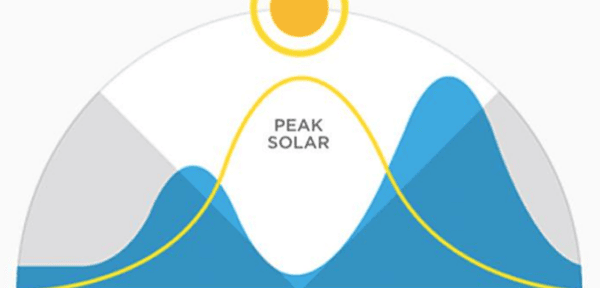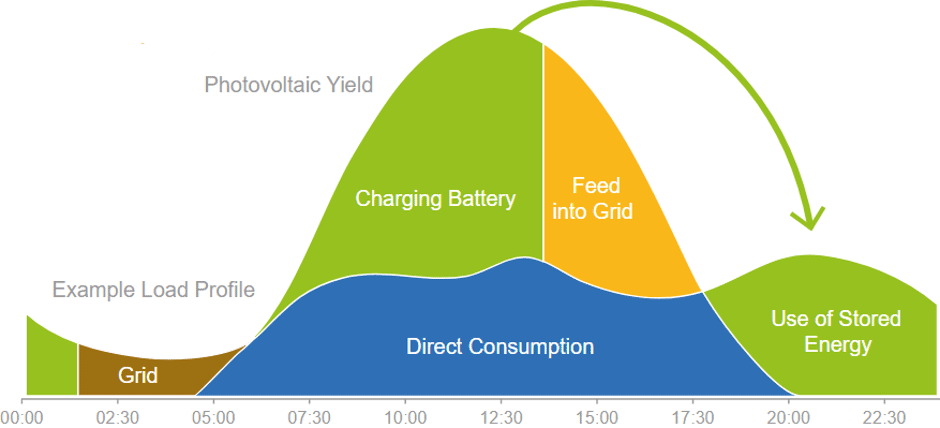SAP 10 – Battery Storage and PV Diverters.

Following on from our previous articles about the changes expected in SAP 10, in this article we cover the addition of diverters and battery storage for PV systems in the next version of SAP.
PV in SAP 2012
In SAP 2012, PV is modelled using the power of the system and physical factors such as over shading, orientation and tilt, which then calculated the energy output. It assumed that 50% of the energy generated by PV was used in the home at 13.19 p/kWh and 50% was exported to the grid, at 6.61 p/kWh. There is no recognition of electricity storage or the ability to change the proportion of solar power used in the home.

Figure 1 – SAP 2012 model
Overshading
Overshading is caused by buildings or trees that reduce the amount of sunlight hitting the PV panels. It is one of the factors applied to the output calculation for a PV system. There are 4 options:
• Heavy: more than 80% of the sky blocked by obstacles
• Significant: >60-80% of the sky blocked by obstacles
• Modest: 20-60% of the sky blocked by obstacles
• None or very little: >20% of the sky blocked by obstacles
When PV panels are installed by microgeneration certification scheme assessors, the overshading factor is calculated rather than SAP default values used. In SAP 10, these overshading factors have been adjusted to better reflect the overshading factors used by a microgeneration certification scheme assessor. This affects all the options except ‘none or very little’ and the factors have increased, which results in a reduced energy output from the system.
Solar generation vs demand
Whilst solar PV generates clean energy, the downfall is when generation is not made use of in times when there is high demand. In figure 2 below, the blue line demonstrates the electricity demand for a typical household throughout the day and the yellow line shows the solar energy generated. As the energy generated from PV peaks around midday and the most demanding times for our energy requirement are mornings and evenings, it would be most efficient to harness the solar power produced during the day to reduce the electricity the household has to draw from the grid and pay for at other times of the day.

Figure 2 – Source: http://www.teslamotors.com/en_AU/powerwall
Batteries that store the daytime solar power or diverters that use the solar power to heat hot water with an immersion can do just that.
Solar battery storage
A battery storage system can store the surplus energy generated by PV panels which is not required for direct consumption at the time it is generated, resulting in a more efficient use of energy.
In figure 3 below, the small, brown section demonstrates what the household will need to use from the grid before the sun rises. When the sun rises the PV panels can generate energy which is divided up to charge the battery, used for direct consumption, as well as any surplus exported to the grid. In the evenings when peak household demand occurs, the energy stored earlier can be used.

Figure 3
In SAP 10, the calculation will be able to use the battery capacity to adjust the split of energy used in the dwelling and energy exported to the grid.
The maximum capacity for a battery in the SAP model is 15kWh. To put that in context, a 2.5kWp system would produce around 6kWh per day and the average household electricity usage is 8-10kWh per day. When we compared the SAP rating in SAP 2012 and SAP 10 for various PV systems (with overshading set to none so the change to overshading factors had no effect), we found there was an increase of between 2 and 4 SAP points.
A solar battery storage system is separate to a standard PV system. It will have metal casing and is usually around 1m+ tall. Battery storage systems are very heavy so they will likely be located downstairs and, ideally, the surrounding temperature will be above 0°C to avoid the battery using its own power to stay warm, and no more than 25°C to avoid having to use energy to cool (although they are capable operating at temperatures between -20°C to 50°C). The typical cost for a solar battery storage system is approximately £5,000.
It is possible for some battery storage systems to provide backup power should a power cut occur.
Another benefit to battery storage is taking advantage of the ‘time-of-use’ tariff. A recent concept similar to the Economy 7 tariff, the time-of-use tariff has several different rates split up throughout the day – not just one like Economy 7. Charging the battery from the grid when the grid energy is cheapest and using that energy in the home when grid energy is most expensive, could result in additional savings.
To find out more about battery storage systems, you may find the NHBC guide ‘Watts in store? Introduction to energy storage batteries for homes’[1] useful.
PV diverter to immersion
SAP 10 will also include the option for a PV diverter to an immersion.
A diverter senses any surplus electricity and directs it to the immersion heater until the set water temperature is reached. When the hot water temperature is reached the remaining solar generation goes to the grid – without a diverter, all surplus power is sent to the grid. This allows a PV system to charge up the water heating during the day when there is excess solar energy, and the hot water is then ready for use in the evening, reducing the hot water costs on the heating system.
[1] https://www.nhbcfoundation.org/publication/watts-in-store-introduction-to-energy-storage-batteries-for-homes/

Figure 4
If a PV diverter is present, it is likely to be in the same place as the inverter for the PV system that converts the direct current from the PV to alternating current for the dwelling. Remember, a hot water cylinder is required for the property to benefit from a PV diverter. The calculation would reduce the energy required for the water heating.
Our analysis found that inclusion of a PV diverter only increased the SAP rating by 1 point, depending on what proportion of the energy use is for water heating.
The cost of a diverter is between £200 to £500.

Figure 5 – example of a diverter
PV in SAP 10
In SAP 10, the same data about the PV system and its location is required as is required for SAP 2012. The output of the system then takes into account the existence of a battery or diverter, if present, and uses this to adjust the split of exported and used energy.

Figure 6 – SAP 10 model
It is not possible to have both a battery and a diverter in SAP 10 and there is only provision for ‘PV’ battery storage, not battery storage for storing ‘cheaper’ electricity.
The latest on SAP
SAP 10 has now been superseded by SAP 10.1; however, neither version is used for any official purpose. The Future Homes Standard consultation for changes to Part L and F closed in February and we are waiting for the responses to be published – this will dictate what will be included in SAP 10.2.
Dr Lisa Blake, Technical Manager, Sava
Lisa heads up our Technical Team. She joined Sava in 2006 armed with a PhD in Astrophysics and a desire to be part of a company promoting
energy conservation. Since joining Sava she has enjoyed getting to grips with the different methodologies used to measure energy efficiency.